Timeline
Contents
1915-1949
1950-1959
1960-1969
1970-1979
1980-1995
1915-1949
1915. Born in Eveleth Minnesota; one of seven children. Parents: John E. and Anna Emelia (Sundquist) Suomi

1939. B.E. degree from Winona Teacher’s College, Winona, Minnesota.
1938-1942. Taught high school in Minnesota. Took Federal Aviation Administration civilian pilot training program during summer vacation and developed interest in meteorology. Recalls text book was, Meteorology for Pilots by B. C. Haynes, particularly interested in the adiabatic chart. During this period, Suomi wrote to Professor Carl-Gustav Rossby about studying meteorology at the University of Chicago.
1948. Joined University of Wisconsin faculty. Appointed by College of Letters and Science to the Department of Meteorology.
1950-1959
1950-1952. Served as chairman of the Department of Meteorology, University of Wisconsin-Madison.
1953. Ph.D., University of Chicago. Dissertation: The Heat Budget Over a Corn Field, which measured the difference between the amount of energy absorbed and the amount of energy lost in a corn field. Led him to think about the Earth’s heat budget.


1954-1957. Served as chairman of Department of Meteorology, University of Wisconsin-Madison.
1959. Verner Suomi and Robert Parent’s instrument for measuring the heat balance of the earth was included in the payload of Vanguard SLV-6, launched on 22 June. A faulty second stage pressure valve caused mission failure.


1959. Instrumentation developed by Suomi and Parent to measure the earth’s heat balance was included in the payload of Explorer 7X (also known as Explorer S-1), launched on 16 July. The rocket was intentionally destroyed by the Range Safety Officer five and a half seconds after liftoff because of a failure of the power supply to the guidance system. The rocket crashed and burned approximately 150 feet from the blockhouse where Suomi, Parent and others were trapped for about an hour. After it had cooled they hacksawed their instrument package from the wreckage.

Explorer VI newspaper article
1959. Explorer 7 carried Thermal Radiation Experiment.





1960-1969
1961. TIROS 3 launch. Experiments included Suomi’s Low-Resolution Omnidirectional Radiometer.


1962. TIROS 4 launch. Experiments included Suomi’s Low-Resolution Omnidirectional Radiometer.

1963. TIROS 7 launch. Once again, experiments included Suomi’s Low-Resolution Omnidirectional Radiometer.

1963-1964. Served as Chief Scientist of the United States Weather Bureau.
1964. Initial proposal to NASA for an ATS technological experiment submitted by Suomi and Parent.
1965. Proposal to NASA for a spin-scan camera system for the second ATS Spin Stabilized Synchronous Satellite.
1965. Proposal to NASA for a spin-scan camera system for the second ATS Spin Stabilized Synchronous Satellite.
1965. Funding from NASA, NSF, and the State of Wisconsin established the Space Science and Engineering Center.

1966. ESSA 3 launch included Suomi’s experiment, the Flat Plate Radiometer (FPR).
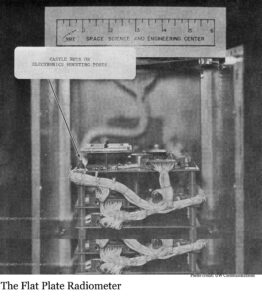
1966. ATS-I launched on 7 December 1966. Suomi’s Spin-Scan Cloud Camera (SSCC) was one of several experiments on-board. The launch of ATS-I into geosynchronous Earth orbit pioneered continuous viewing of weather from space. Suomi understood the benefits that could be gained by observing a single weather phenomenon at frequent intervals. These kinds of observations were not possible using the early, low polar-orbiting satellites.





1967. ESSA 5, Suomi principal investigator on Flat Plate Radiometer Experiment (FPR).
1967. ATS-III launched on 5 November 1967. It sent back the first color images from the Multicolor Spin- Scan Cloud Camera (MSSCC). The ATS-III was the only geostationary satellite with a blue channel which was, and still is, a unique feature. The camera provided color pictures for approximately three months at which time the red and blue channels failed. The system continued to provide black-and-white pictures until 11 December 1974.



1968. Display software developed at SSEC allowing direct interface with ATS image archive.

1968. Suomi a member of the Joint GARP Organizing Committee as it held its first session in Geneva at the WMO Secretariat.
1968. Balloon-Borne Radioaltimeter. Developed by Suomi and graduate student Nadav Levanon, used to measure height of meteorological balloons with great accuracy.

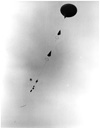
1968. ESSA 7 launch included Suomi’s Flat Plate Radiometer (FPR).
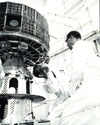
1969. ESSA 9 launched, included Suomi’s Flat Plate Radiometer (FPR).

1969. Suomi is credited with the concept of the VAS instrument. The VAS (a second-order acronym for VISSR (Visible and Infrared Spin Scan Radiometer) Atmospheric Sounder) evolved from a concept for sounding from geosynchronous orbit, which he originally proposed in 1969.
1970-1979
1970. ITOS 1 launched carrying Flat Plate Radiometer (FPR)

1970. NOAA 1 launched, carrying Suomi’s Flat Plate Radiometer (FPR).

1970. High-quality ATS data disseminated world-wide.
1972. Introduction of Man-computer Interactive Data Access System (McIDAS). McIDAS complemented Suomi’s Spin-Scan Cloud Camera in geosynchronous orbit, as a system for acquiring, storing, navigating and animating images from satellites. The combination of these two inventions enabled people to see animated cloud images, as billions now do via TV weather programs. An interesting anecdote is that Suomi saw instant replays on football programs and sought out the technology used for that, as a way to animate satellite images.


1972. The VAS concept was formalized in April 1972 by the University of Wisconsin in the form of a preliminary instrument specification. Later in 1972 the National Oceanic and Atmospheric Administration (NOAA) requested that the National Aeronautics and Space Administration (NASA) proceed with the development of a VAS instrument.
To see a list of VAS related materials held by the Schwerdtfeger Library, go here
1972. McIDAS was the first interactive meteorology system, combining satellite images with data from “conventional” sources such as surface observations and rawinsonde balloons. The system enabled various data analyses, including estimating winds from time sequences of satellite cloud images.

1973. Member of the television photography science team for the Mariner 10 mission to Venus and Mercury.

1974. The success of the ATS program led to NASA’s Synchronous Meteorological Satellite (SMS) with infrared camera, launched on 17 May 1974.
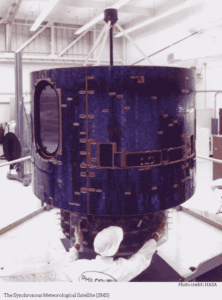
1974. Global Atmospheric Research Program (GARP) Atlantic Tropical Experiment (GATE), benefitted from the IR camera that Suomi recommended.

1974. By applying video-processing capability of McIDAS, nowcasting concept developed emphasizing mesoscale atmospheric features for better current forecasts.
1975. SMS-2 launched on 6 February 1975.


1975. GOES-1 launched on 16 October 1975.

1977. Voyager 1, imaging science team member for Jupiter and Saturn global motions and cloud distributions.
1977. Voyager 2, imaging science team member.
1978. SSEC adapted videocassette recorder to archive digital satellite data. McIDAS had the first archive of satellite images using “slant track” and then UMATIC video tape drives.
1978. Pioneer Venus Small Probe (North), Suomi principal investigator for the Net Flux Radiometer (SNFR) Experiment.


1978. Pioneer Venus Small Probe (Night), Suomi principal investigator for Net Flux Radiometer (SNFR) Experiment.
1978. Pioneer Venus Small Probe (Day), Suomi principal investigator for Net Flux Radiometer (SNFR) Experiment.
1978. First GARP Global Experiment (FGGE) planned for 1978-1979. SSEC was selected to archive satellite wind vectors from cloud heights. Suomi played key organizing role.

1979. SSEC designated national archive for GOES data.
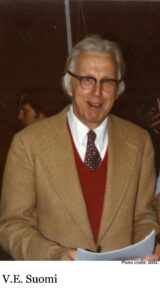
1979. SSEC led the design of the High-resolution Interferometer Sounder (HIS), the first hyperspectral sounder for GOES, in partnership between the Santa Barbara Research Center (SBRC), Bomem, NOAA, and NASA. This Phase A design effort proved the feasibility of this important advance for improving vertical resolution, and was twice very close to being implemented into operations in the 1980s.
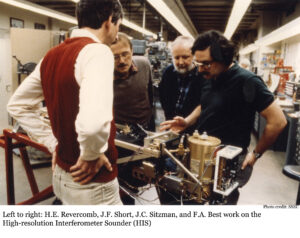
1980-1995
1980. Cooperative Institute for Meteorological Satellite Studies (CIMSS) founded by Dr. Suomi through a Memorandum of Understanding (MOU) with NOAA and NASA.
1980. GOES-4 launched 9 September 1980. It was the first geostationary satellite to provide continuous vertical profiles of atmospheric temperature and moisture. The instrument was a modification of the original spin-scan design with additional detectors for proper spectral bands. The Visible Infrared Spin-Scan Radiometer (VISSR) Atmospheric Sounder (VAS) became the first geostationary sounder.


1980. McIDAS installations continued to expand including McIDAS support to the National Hurricane Center, NESDIS’ World Weather Building, and space shuttle launches supported with real-time weather data.
1983. VAS data incorporated into many new products for the National Weather Service.

1988. SSEC participated in software and instrument development for next-generation geostationary satellites.
1991. World-wide network of McIDAS sites continued to expand.

1992. VAS cloud products used hourly by the National Weather Service.
1994. GOES-8 launched 13 April 1994 and was first GOES launched on a three axis stable platform. SSEC heavily involved with ingestors, simulations and technical expertise.

1994. While the original spin-scan design is no longer in use in the United States, Suomi’s basic concept was adopted for many satellites and space probes built for NASA, the National Oceanic and Atmospheric Administration, the European Space Agency, the Japanese Meteorological Agency and the Chinese National Satellite Meteorological Center.
1995. Dr. Suomi died July 30, 1995 at University Hospital in Madison, Wisconsin.
